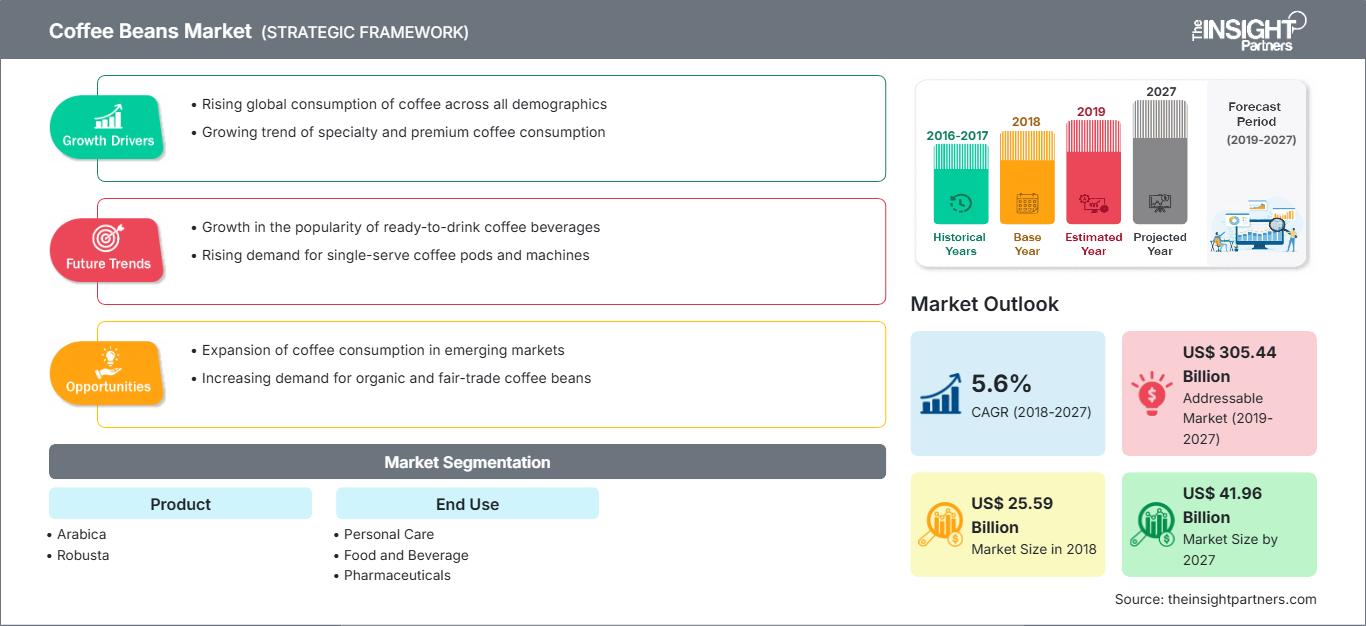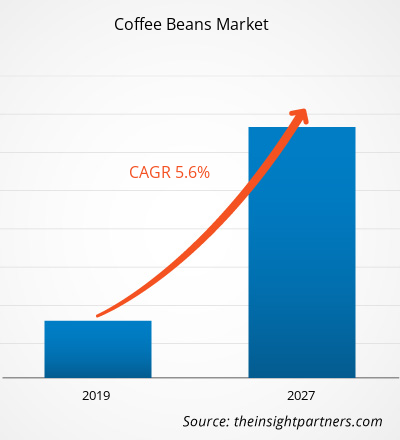[研究报告]2018 年咖啡豆市场价值为 255.917 亿美元,预计到 2027 年将达到 419.624 亿美元;预计 2019 年至 2027 年的复合年增长率为 5.6%。
咖啡豆是咖啡树结出的种子,咖啡树是咖啡的丰富来源。咖啡豆严格来说不是豆子,但由于其外观类似于真正的豆子,因此被称为咖啡豆。就像普通的樱桃一样,咖啡豆也是一种所谓的核果。咖啡树的两个最重要的品种是阿拉比卡咖啡和罗布斯塔咖啡。根据一些研究,咖啡树最早是由一位名叫卡尔迪的牧羊人在埃塞俄比亚发现的。咖啡豆是一种主要的经济作物,也是重要的出口产品。根据产品,咖啡豆市场细分为阿拉比卡咖啡、罗布斯塔咖啡和其他品种。 2018 年,阿拉比卡咖啡占据了主要市场份额,占据了主导地位。阿拉比卡咖啡树出产的咖啡品质优良,香气浓郁。与罗布斯塔咖啡相比,阿拉比卡咖啡豆扁平细长,咖啡因含量较低。阿拉比卡咖啡豆热量低,富含烟酸、钾和锰等矿物质。高品质的阿拉比卡咖啡略带甜味,带有巧克力、坚果和焦糖的味道。它们甚至可能略带苦味和酸味。
预计亚太地区在预测期内的复合年增长率最高为 6.0%。由于不同咖啡产品在亚太地区消费者中越来越受欢迎,预计该地区将在全球咖啡豆市场中获得相当大的份额。印度、泰国、菲律宾和印度尼西亚等国家的咖啡馆和咖啡店数量正在增加,这进一步促进了咖啡豆市场的发展。东南亚的气候和地理位置非常适合咖啡种植。此外,该地区的咖啡文化和咖啡生产专业知识促进了该地区咖啡产业的蓬勃发展。一些东南亚国家已成为咖啡出口巨头,包括印度尼西亚、越南和老挝。泰国也因其日益增长的咖啡需求而吸引了众多企业和投资。此外,菲律宾决心重振其咖啡产业,以瞄准利基市场和日益增长的国内特色咖啡需求。目前,越南是继巴西之后的世界第二大咖啡出口国。2017年,咖啡总产量为29,500,000袋(每袋60公斤),其次是印度尼西亚,总产量为10,902,000袋。
COVID-19对咖啡豆市场的影响
COVID-19疫情于2019年12月在中国武汉首次爆发,此后迅速蔓延至全球。截至2020年3月,中国、意大利、伊朗、印度、俄罗斯、西班牙、韩国、法国、德国和美国是确诊病例和死亡人数最多的国家。根据世界卫生组织的最新数据,全球确诊病例约9,843,073例,死亡人数495,760例。由于封锁、旅行禁令和企业倒闭,COVID-19疫情已对各国的经济和各行各业造成影响。全球食品加工行业是受疫情影响最大的行业之一,面临工厂停工、供应链中断、科技活动取消以及办公室停工等严重影响。
自定义此报告以满足您的要求
您将免费获得任何报告的定制,包括本报告的部分内容,或国家级分析、Excel 数据包,以及为初创企业和大学提供超值优惠和折扣
咖啡豆市场: 战略洞察

-
获取本报告的主要市场趋势。这个免费样本将包括数据分析,从市场趋势到估计和预测。
咖啡是世界上消费最多的饮料之一。咖啡在年轻人群中的受欢迎程度激增,尤其是在印度、中国和菲律宾等国家,这刺激了对咖啡豆的需求。咖啡消费有几个主要动机,例如功能性、口味和愉悦感、习惯、传统、文化和社交。中产阶级人口的增加和整体生活水平的提高,促进了对咖啡和咖啡饮料的需求增加。办公室专业人士的咖啡消费量也显著增长。本地咖啡店和新咖啡店的开业和扩张是推动咖啡需求的另一个因素,这反过来又促进了咖啡豆市场的增长。此外,牛奶消费量的增加有利于市场增长,因为消费者将咖啡混入牛奶中以获得更好的口感。在咖啡馆里长时间逗留和享受高品质饮品的机会也吸引了消费者的注意,这反过来又增加了对咖啡的需求。除此之外,咖啡店也是图书馆的替代品。此外,喝咖啡被年轻人视为一种时尚和轻松的生活方式,这反过来又导致了咖啡需求的激增。咖啡豆以不同的方式处理,以便以各种类型的混合咖啡出售,并在零售店、杂货店和网上销售。
产品洞察
根据产品,咖啡豆市场细分为阿拉比卡咖啡、罗布斯塔咖啡和其他咖啡。阿拉比卡咖啡在 2018 年占据了全球咖啡豆市场的最大份额,预计罗布斯塔咖啡在预测期内将以更高的复合年增长率增长。阿拉比卡咖啡是最古老、最主要的咖啡品种。它来自阿拉比卡咖啡灌木,也被称为山地咖啡或阿拉比卡咖啡。阿拉比卡咖啡占世界咖啡产量和消费量的近 60%。阿拉比卡咖啡豆原产于埃塞俄比亚、南苏丹和也门,自 12 世纪以来便开始种植和栽培。目前,从非洲到拉丁美洲,从亚洲到加勒比地区,世界各地都有种植和栽培阿拉比卡咖啡豆。阿拉比卡咖啡豆为乔木或大型灌木,开白花,结鲜红色浆果。每颗浆果含有两颗种子,最终发育成咖啡豆。阿拉比卡咖啡豆大约需要七年才能完全成熟并结出果实。此外,在这七年里,咖啡无法收获。与罗布斯塔咖啡豆相比,阿拉比卡咖啡豆的脂质含量高出 60%,糖分含量是罗布斯塔咖啡豆的两倍。阿拉比卡咖啡豆耐低温,在平均气温 15 至 24 摄氏度之间生长最佳。一种阿拉比卡咖啡豆含有少量咖啡因。阿拉比卡咖啡富含抗氧化剂,以及少量维生素和矿物质,如烟酸、镁、锰和钾。优质的阿拉比卡咖啡略带甜味,并带有坚果、焦糖和巧克力的味道。路易达孚公司、Bharat Company Depot 等公司都提供阿拉比卡咖啡豆。
最终用途洞察
根据最终用途,咖啡豆市场细分为食品饮料、个人护理和药品。食品饮料领域在 2018 年全球咖啡豆市场中占据最大份额,预计在预测期内将实现最快增长率。咖啡是商业化的食品之一,也是全球消费最广泛的饮料。咖啡消费量增长的原因包括通过选择不同品种来提高咖啡品质、改进农业实践和开设专卖店。咖啡豆被用于各种食品中,因为它们富含抗氧化剂,可以降低患糖尿病的风险并对抗炎症。摩卡咖啡曲奇、咖啡糖曲奇、咖啡酱牛排、咖啡巧克力布朗尼和咖啡酱脆皮烤猪肉等食品都是用咖啡或咖啡豆制作的。咖啡豆在咖啡馆中的用途摩卡曲奇不仅带来美味的咖啡风味,还增添了浓郁的巧克力风味。咖啡糖曲奇则带来香甜的口感和浓郁的咖啡香。浓郁的布朗尼甜点搭配顺滑的咖啡风味,为咖啡增添了令人垂涎的美味。世界各地的咖啡饮品风格各异,但其制作方法和配料各不相同。浓缩咖啡、浓缩玛奇朵和卡布奇诺是大多数人喜爱的咖啡饮品。
企业通常会采用并购和研发的手段来扩大其全球影响力,这进一步影响了市场规模。咖啡豆市场的参与者,例如Illycafe SpA和Peets Coffee,一直在实施并购和研发战略,以扩大客户群并在全球范围内获得显著的市场份额,这也使得这些参与者能够在全球范围内维护其品牌名称。例如,2019年8月,Illycafe SpA宣布从Euro Food Brands(EFB集团)收购其英国分销业务。Euro Food Brands此前仅负责Illy产品在英国的分销。此次收购旨在招聘更多员工来管理和发展公司。
咖啡豆市场区域洞察
The Insight Partners 的分析师已详尽阐述了预测期内影响咖啡豆市场的区域趋势和因素。本节还讨论了北美、欧洲、亚太地区、中东和非洲以及南美和中美洲的咖啡豆市场细分和地域分布。
咖啡豆市场报告范围
| 报告属性 | 细节 |
|---|---|
| 市场规模 2018 | US$ 25.59 Billion |
| 市场规模 2027 | US$ 41.96 Billion |
| 全球复合年增长率 (2018 - 2027) | 5.6% |
| 历史数据 | 2016-2017 |
| 预测期 | 2019-2027 |
| 涵盖的领域 |
By 产品
|
| 覆盖地区和国家 |
北美
|
| 市场领导者和主要公司简介 |
|
咖啡豆市场参与者密度:了解其对商业动态的影响
咖啡豆市场正在快速增长,这得益于终端用户需求的不断增长,而这些需求的驱动因素包括消费者偏好的演变、技术进步以及对产品优势的认知度的提升。随着需求的增长,企业正在扩展产品线,不断创新以满足消费者需求,并抓住新兴趋势,从而进一步推动市场增长。

- 获取 咖啡豆市场 主要参与者概述
- 阿拉比卡咖啡
- 罗布斯塔咖啡
- 其他咖啡
全球咖啡豆市场 - 按最终用途分类
- 食品和饮料
- 个人护理
- 药品
公司简介
- Bharat Coffee Depot
- Death Wish Coffee Company
- The Gold Coffee Company
- Hawaiian Isles Kona Coffee Company Ltd.
- Kicking Horse Whole Beans Company
- Illycafe SpA Company
- The Coffee Beans Co.
- Peets Coffee and Tea, Inc.
- Starbucks Coffee Company
- Direct Coffee GmbH
- 历史分析(2 年)、基准年、预测(7 年)及复合年增长率
- PEST和SWOT分析
- 市场规模、价值/数量 - 全球、区域、国家
- 行业和竞争格局
- Excel 数据集
近期报告
相关报告
客户评价
购买理由
- 明智的决策
- 了解市场动态
- 竞争分析
- 客户洞察
- 市场预测
- 风险规避
- 战略规划
- 投资论证
- 识别新兴市场
- 优化营销策略
- 提升运营效率
- 顺应监管趋势






















 获取免费样品 - 咖啡豆市场
获取免费样品 - 咖啡豆市场